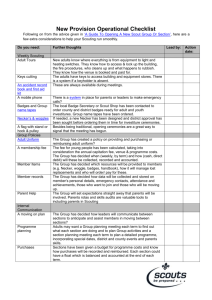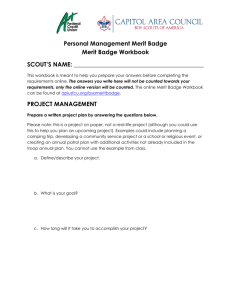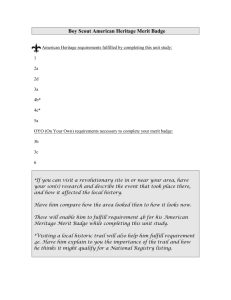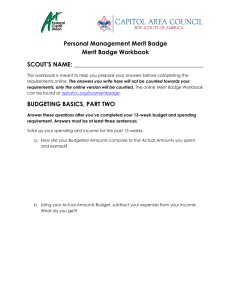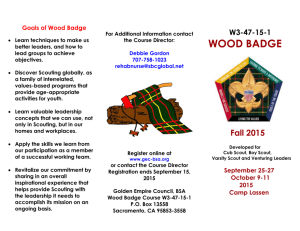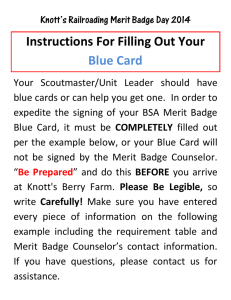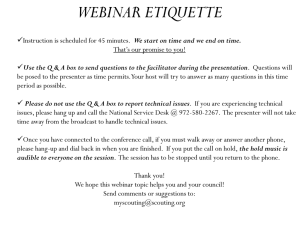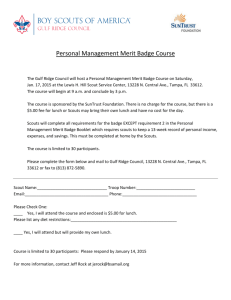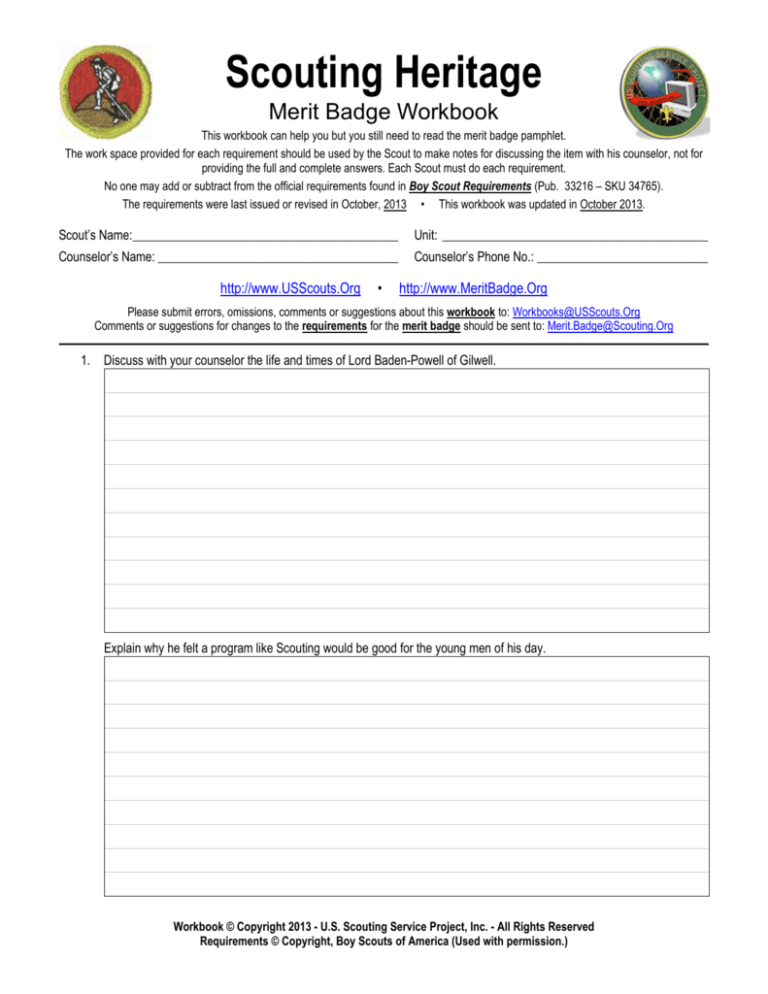
Scouting Heritage
Merit Badge Workbook
This workbook can help you but you still need to read the merit badge pamphlet.
The work space provided for each requirement should be used by the Scout to make notes for discussing the item with his counselor, not for
providing the full and complete answers. Each Scout must do each requirement.
No one may add or subtract from the official requirements found in Boy Scout Requirements (Pub. 33216 – SKU 34765).
The requirements were last issued or revised in October, 2013 • This workbook was updated in October 2013.
Scout’s Name:__________________________________________
Unit: __________________________________________
Counselor’s Name: ______________________________________
Counselor’s Phone No.: ___________________________
http://www.USScouts.Org
•
http://www.MeritBadge.Org
Please submit errors, omissions, comments or suggestions about this workbook to: Workbooks@USScouts.Org
Comments or suggestions for changes to the requirements for the merit badge should be sent to: Merit.Badge@Scouting.Org
______________________________________________________________________________________________________________________________________________
1. Discuss with your counselor the life and times of Lord Baden-Powell of Gilwell.
Explain why he felt a program like Scouting would be good for the young men of his day.
Workbook © Copyright 2013 - U.S. Scouting Service Project, Inc. - All Rights Reserved
Requirements © Copyright, Boy Scouts of America (Used with permission.)
Scouting Heritage
Scout's Name: ________________________
Include in your discussion how Scouting was introduced in the United States, and the origins of Boy Scouting and Cub
Scouting under Baden-Powell.
Introduction in the United States:
Origins of Boy Scouting and Cub Scouting under Baden-Powell:
Scouting Heritage - Merit Badge Workbook
Page. 2 of 8
Scouting Heritage
Scout's Name: ________________________
2. Do the following:
a. Give a short biographical summary of any TWO of the following, and tell of their role in how Scouting developed
and grew in the United States prior to 1940.
1. Daniel Carter Beard
2. William D. Boyce
3. Waite Phillips
4. Ernest Thompson Seton
5. James E. West
Scouting Heritage - Merit Badge Workbook
Page. 3 of 8
Scouting Heritage
Scout's Name: ________________________
b. Discuss the significance to Scouting of any TWO of the following:
1. Brownsea Island
2. The First World Scout
Jamboree
3. Boy Scout Handbook
4. Boys’ Life magazine
3. Discuss with your counselor how Scouting’s programs have developed over time and been adapted to fit different age
groups and interests (Cub Scouting, Boy Scouting, Exploring, Venturing)
Scouting Heritage - Merit Badge Workbook
Page. 4 of 8
Scouting Heritage
Scout's Name: ________________________
4. Do ONE of the following:
a.
Attend either a BSA national jamboree, OR world Scout jamboree, OR a national BSA high-adventure base.
Event Attended
While there, keep a journal documenting your day-to-day experiences. Upon your return, report to your
counselor what you did, saw, and learned. You may include photos, brochures, and other documents in your
report.
b. Write or visit the National Scouting Museum in Irving, Texas.* Obtain information about this facility. Give a short
report on what you think the role of this museum is in the Scouting program.
*
If you visited the BSA’s national traveling tour, Adventure Base 100, in 2010, you may use that experience
to fulfill requirement 4b.
c. Visit an exhibit of Scouting memorabilia or a local museum with a Scouting history gallery, or (with your parent's
permission and counselor's approval) visit with someone in your council who is recognized as a dedicated
Scouting historian or memorabilia collector. Learn what you can about the history of Boy Scouting. Give a short
report to your counselor on what you saw and learned.
Exhibit or Individual visited
Scouting Heritage - Merit Badge Workbook
Page. 5 of 8
Scouting Heritage
Scout's Name: ________________________
5. Learn about the history of your unit or Scouting in your area. Interview at least two people (one from the past and one
from the present) associated with your troop. These individuals could be adult unit leaders, Scouts, troop committee
members, or representatives of your troop’s chartered organization. Find out when your unit was originally chartered.
Create a report of your findings on the history of your troop, and present it to your patrol or troop or at a court of honor,
and then add it to the troop’s library. This presentation could be in the form of an oral/written report, an exhibit, a
scrapbook, or a computer presentation such as a slide show.
1.
2.
Scouting Heritage - Merit Badge Workbook
Page. 6 of 8
Scouting Heritage
Scout's Name: ________________________
6.
Make a collection of some of your personal patches and other Scouting memorabilia. With their permission, you may
include items borrowed from family members or friends who have been in Scouting in the past, or you may include
photographs of these items. Show this collection to your counselor, and share what you have learned about items in the
collection. (There is no requirement regarding how large or small this collection must be.)
7.
Reproduce the equipment for an old-time Scouting game such as those played at Brownsea Island. You may find one
on your own (with your counselor’s approval), or pick one from the Scouting Heritage merit badge pamphlet. Teach and
play the game with other Scouts.
8. Interview at least three people (different from those you interviewed for requirement 5) over the age of 40 who were
Scouts. Find out about their Scouting experiences. Ask about the impact that Scouting has had on their lives. Share
what you learned with your counselor.
1.
2.
3.
Requirement resources can be found here:
http://www.meritbadge.org/wiki/index.php/Scouting Heritage#Requirement resources
Scouting Heritage - Merit Badge Workbook
Page. 7 of 8
Important excerpts from the Guide To Advancement - 2013, No. 33088 (SKU-618673)
[1.0.0.0] — Introduction
The current edition of the Guide to Advancement is the official source for administering advancement in all Boy Scouts of America programs: Cub
Scouting, Boy Scouting, Varsity Scouting, Venturing, and Sea Scouts. It replaces any previous BSA advancement manuals, including Advancement
Committee Policies and Procedures, Advancement and Recognition Policies and Procedures, and previous editions of the Guide to Advancement.
[Page 2, and 5.0.1.4] — Policy on Unauthorized Changes to Advancement Program
No council, committee, district, unit, or individual has the authority to add to, or subtract from, advancement requirements. There are limited
exceptions relating only to youth members with special needs. For details see section 10, “Advancement for Members With Special Needs”.
[Page 2] — The “Guide to Safe Scouting” Applies
Policies and procedures outlined in the Guide to Safe Scouting, No. 34416, apply to all BSA activities, including those related to advancement and
Eagle Scout service projects.
[7.0.3.1] — The Buddy System and Certifying Completion
A youth member must not meet one-on-one with an adult. Sessions with counselors must take place where others can view the interaction, or the
Scout must have a buddy: a friend, parent, guardian, brother, sister, or other relative— or better yet, another Scout working on the same badge— along
with him attending the session.
When the Scout meets with the counselor, he should bring any required projects. If these cannot be transported, he should present evidence, such as
photographs or adult verification. His unit leader, for example, might state that a satisfactory bridge or tower has been built for the Pioneering merit
badge, or that meals were prepared for Cooking. If there are questions that requirements were met, a counselor may confirm with adults involved.
Once satisfied, the counselor signs the blue card using the date upon which the Scout completed the requirements, or in the case of partials, initials
the individual requirements passed.
Note that from time to time, it may be appropriate for a requirement that has been met for one badge to also count for another. See “Fulfilling More
Than One Requirement With a Single Activity,” 4.2.3.6.
[7.0.3.2] — Group Instruction
It is acceptable— and sometimes desirable— for merit badges to be taught in group settings. This often occurs at camp and merit badge midways or
similar events. Interactive group discussions can support learning. The method can also be attractive to “guest experts” assisting registered and
approved counselors. Slide shows, skits, demonstrations, panels, and various other techniques can also be employed, but as any teacher can attest,
not everyone will learn all the material.
There must be attention to each individual’s projects and his fulfillment of all requirements. We must know that every Scout — actually and
personally— completed them. If, for example, a requirement uses words like “show,” “demonstrate,” or “discuss,” then every Scout must do that. It is
unacceptable to award badges on the basis of sitting in classrooms watching demonstrations, or remaining silent during discussions.
It is sometimes reported that Scouts who have received merit badges through group instructional settings have not fulfilled all the requirements. To
offer a quality merit badge program, council and district advancement committees should ensure the following are in place for all group instructional
events.
Merit badge counselors are known to be registered and approved.
Any guest experts or guest speakers, or others assisting who are not registered and approved as merit badge counselors, do not accept the
responsibilities of, or behave as, merit badge counselors, either at a group instructional event or at any other time. Their service is temporary, not
ongoing.
Counselors agree not to assume prerequisites have been completed without some level of evidence that the work has been done. Pictures and
letters from other merit badge counselors or unit leaders are the best form of prerequisite documentation when the actual work done cannot be
brought to the camp or site of the merit badge event.
There is a mechanism for unit leaders or others to report concerns to a council advancement committee on summer camp merit badge programs,
group instructional events, and any other merit badge counseling issues— especially in instances where it is believed BSA procedures are not
followed. See “Reporting Merit Badge Counseling Concerns,” 11.1.0.0.
There must be attention to each individual’s projects and his fulfillment of all requirements. We must know that every Scout— actually and
personally— completed them.
[7.0.3.3] — Partial Completions
A Scout need not pass all the requirements of one merit badge with the same counselor. It may be that due to timing or location issues, etc., he must
meet with a different counselor to finish the badge. The Application for Merit Badge has a place to record what has been finished— a “partial.” In the
center section on the reverse of the blue card, the counselor initials for each requirement passed. In the case of a partial completion, the counselor
does not retain his or her portion of the card. A subsequent counselor may choose not to accept partial work, but this should be rare. A Scout, if he
believes he is being treated unfairly, may work with his unit leader to find another counselor. An example for the use of a signed partial would be to
take it to camp as proof of prerequisites. Partials have no expiration except the Scout’s 18th birthday. Units, districts, or councils shall not establish
other expiration dates for partial merit badges.
[7.0.4.8] — Unofficial Worksheets and Learning Aids
Worksheets and other materials that may be of assistance in earning merit badges are available from a variety of places including unofficial sources
on the Internet and even troop libraries. Use of these aids is permissible as long as the materials can be correlated with the current requirements that
Scouts must fulfill. Completing “worksheets” may suffice where a requirement calls for something in writing, but this would not work for a requirement
where the Scout must discuss, tell, show, or demonstrate, etc. Note that Scouts shall not be required to use these learning aids in order to complete a
merit badge.
Attachment
(NOTE: It is not necessary to print this page.)
Page 8 of 8

